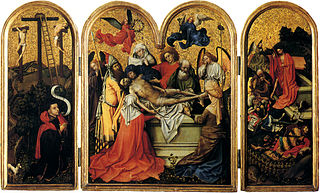罗伯特·康平Campin, Robert
( 佛莱蒙大师 )
罗伯特·康平(R. Campin, 1375-1444)也被称作佛莱蒙大师。我们无法确知他的真实姓名,也不了解他的生平事迹,但他的作品却流传下来。罗伯特·康平(佛莱蒙大师)的代表作是《麦洛德祭坛画》,这是一幅三叶祭坛画,大约作于1425年,在这幅作品中我们可以看到一种穿透画面的空间感,一种现实世界的真实反映。这在尼德兰绘画中实属首创。《麦洛德祭坛画》中间描绘的是受胎告知的内容,两旁左幅是捐助人的像,右幅是木匠约瑟在做鼠夹。
中国美术网 09-04 浏览
生活
的Seilern三部曲或基督的埋没,c 1425。只有两个Campin三部曲的生存[3]
的Merode祭坛的装饰品罗伯特•Campin 1425 - 1428
Campin首次出现了图尔奈从1405 - 6的档案,作为一个自由掌握的公会的画家,有很多猜测他的起源和出生地实际上是未知的,虽然他有时是出生在上市瓦朗谢讷.[4]1410年,他收购了国籍,这表明他没有在那里出生。
他获得公会院长的办公室,教堂和其他公民办公室看守人的职权,并最终跑一个大车间。然而,到1432年,他失去了公民地位因为丑闻,可能他在政治动荡。1429年,他被判犯有隐瞒证据,并判处去朝圣之旅,1432年被定罪通奸和放逐了一年。
玛格丽特的勃艮第的妻子荷兰的数和妹妹的无畏的约翰,勃艮第公爵代表他干预,这是罚款。[1][2]的日期为Werl祭坛的装饰品(1438)展示了他继续工作(两外的翅膀普拉多博物馆;主面板丢失)。他死于图尔奈。
身份和风格
1438年的右侧面板了三部曲Werl,现在在普拉多博物馆,马德里
尽管负债累累的14世纪手稿照明,Campin显示更大的权力现实的观察比其他任何画家在他面前。他是第一个尝试使用以石油为基础的颜色,代替基于鸡蛋的蛋彩画,实现典型颜色的亮度。Campin使用新技术来表达强,圆形人物造型光与影在成分复杂的观点。它仍然是一个有争议的问题是大家公认的复杂的象征意义多远工作存在的范艾克Campin也存在于工作。
艺术历史学家长期以来一直渴望跟踪的开端北方文艺复兴时期——证据去远比在意大利。很长一段时间人们认为Jan范艾克是第一个画家充分利用创新明显手稿照明板画。由19世纪末很明显,然而,范艾克的当代艺术家谁画的一些作品,包括Merode祭坛的装饰品。追溯到大约1428年,祭坛的装饰品(现在的回廊的大都会博物馆)是洋溢着爱的注意细节和现实主义。其他三个面板以类似的方式,应该来自所谓的修道院Flemalle(它已经建立有,事实上,没有这样的修道院),现在在法兰克福。这是认为这些作品属于一个“Flemalle大师”,当时他的身份不可能建立。
圣维罗妮卡的画像,归因于罗伯特Campin
在20世纪,一些学者认为Flemalle的主人可能是罗伯特•Campin记录作为一个画家图尔奈从1406年开始。论点转身一篇论文提到两个学生进入他的工作室在1427年雅克Daret和Rogelet de la牧场。后者可能是Rogier van der Weyden。一个证据确凿的装饰画通过Daret显示惊人的相似Flemalle大师的作品,所做的早期作品Rogier。因此,人们很容易认为Daret和Rogier门徒Flemalle的主人,即罗伯特Campin。然而,另一种可能性是,Flemalle板画了Rogier自己当他还在二十多岁。一些学者甚至认为著名的沉积在普拉多(马德里)Campin而不是Van der Weyden。
最严密的定义是来自他自己的手只包括“Flemalle”面板,a的诞生在第戎,被钉在十字架上的小偷在法兰克福(十字架)的片段,两个男人和女人的肖像(约1430),在伦敦,或许了三部曲Seilern。这个,不包括最著名的作品通常归因于他,然后分配给他的车间或追随者,Lorne坎贝尔的位置。[2]
工作
了三部曲埋没(或“Seilern三部曲”科陶德研究所、伦敦)可以上溯到1425。[5]中央面板显示了他对雕塑的债务的时间(Campin已知彩饰几个雕像)。在这之后,他画圣母的婚姻(博物馆普拉多电影院,马德里)和诞生(德第戎美术博物馆)1420 - 1420。
大约1425 - 1428 Campin画Merode祭坛的装饰品,一个三张相联镶画的(3)委托私人使用。的报喜占据了中央面板。的大天使加百列显示接近玛丽,她坐着看书。她描述了一个严守的中产阶级佛兰德回家。几个工作归功于罗伯特Campin可能看到的赫米蒂奇,包括双连画板描绘三位一体和圣母和耶稣的画像。其他作品中显示普拉多博物馆,伦敦国家美术馆.
Life
Campin first appears as settled in Tournai from the archives of 1405–6, as a free master of the guild of painters, and there has been a lot of speculation about his origin and birthplace which is actually unknown, although he is sometimes listed as having been born in Valenciennes.[4] In 1410 he bought into citizenship, suggesting he was not born there.
He attained the offices of dean of the guild and wardenship of a church and other civic office, and eventually ran a large workshop. By 1432, however, he lost his civic positions because of scandals, and probably his role in political disturbances in the city. In 1429 he was found guilty of withholding evidence, and sentenced to go on a pilgrimage, and in 1432 was convicted of adultery and banished for a year.
Margaret of Burgundy, wife of the Count of Holland and sister of John the Fearless, Duke of Burgundy intervened on his behalf, and this was reduced to a fine. The dated Werl Altarpiece (1438) shows he continued to work (the two outer wings are in the Prado; the main panel is lost). He died in Tournai.
Identity and style
Although heavily indebted to 14th centurymanuscript illumination, Campin displayed greater powers of realistic observation than any other painter before him. He was one of the first to experiment with the use of oil-based colors, in lieu of egg-based tempera, to achieve the brilliance of color typical for this period. Campin used the new technique to convey strong, rounded characters by modelling light and shade in compositions of complex perspectives. It remains a matter of debate how far the complex symbolism that is generally accepted as existing in the work of Van Eyck also exists in the work of Campin.
Art historians have long been keen to trace the beginnings of the Northern Renaissance - with far less evidence to go on than in Italy. For a long time it was thought that Jan van Eyck was the first painter to make full use of the innovations apparent in manuscript illumination in panel painting. By the end of the 19th century it became clear, however, that Van Eyck was the contemporary of an artist who painted a number of works, including the Mérode Altarpiece. Dated to about 1428, the altarpiece (now in the Cloisters of the Metropolitan Museum) is permeated with loving attention to details and realism. Three other panels in a similar manner, supposed to come from the so-called abbey of Flémalle (it has been established that there was, in fact, no such abbey), are now in Frankfurt. It was argued that these works belong to one "Master of Flémalle", whose identity at that time could not be established.
In the 20th century, several scholars suggested that the Master of Flémalle may be Robert Campin, documented as a master painter in Tournai from 1406. The argument turns around a paper mentioning two pupils entering his studio in 1427 - Jacques Daret and Rogelet de la Pasture. The latter was probably Rogier van der Weyden. A very well-documented altarpiece by Daret shows striking similarities with the works of Master of Flémalle, as do early works by Rogier. Therefore, it is tempting to assume that both Daret and Rogier were disciples of the Master of Flémalle, i.e. Robert Campin. Another possibility, however, is that the Flémalle panels were painted by Rogier himself when he was still in his twenties. Some scholars have even attributed the famousDeposition in the Prado (Madrid) to Campin rather than Van der Weyden.
The tightest definition of the works from his own hand includes only the "Flémalle" panels, a'Nativity at Dijon, a Crucified Thief (fragment of a Crucifixion) in Frankfurt, two portraits of a man and woman in London (of around 1430), and perhaps the Seilern Triptych. This, which excludes the best known works usually attributed to him, which are then assigned to his workshop or followers, is the position taken by Lorne Campbell.
Work
The Entombment Triptych (or "Seilern Triptych" Courtauld Institute, London) is dated to around 1425.The central panel shows his debt to the sculpture of the time (Campin was known to have polychromed several statues). After this, he painted the Marriage of the Virgin (Museo del Prado, Madrid) and Nativity (Musée des Beaux-Arts de Dijon) around 1420-1425.
Around 1425-1428 Campin painted the Mérode Altarpiece, a triptych (three paneled paintings) commissioned for private use. The Annunciation occupies the central panel. The Archangel Gabriel is shown approaching Mary, who sits reading. She is depicted in a well-kept middle-class Flemish home. Several works attributed to Robert Campin may be seen in the Hermitage, including diptych panels depicting The Holy Trinity and The Virgin and Child. Other works are displayed in the Prado, and the London National Gallery.
艺术官网信息声明
1、本站美术网信息均来自于美术家自己或其朋友、网络等方式,本站无法确定每条信息或事件的真伪,仅做浏览者参考。
2、只要用户使用本站则意味着该用户以同意《本站注册及使用协议》,否则请勿使用本站任何服务。
3、信息删除不收任何费用,VIP会员修改信息终身免费(VIP会员点此了解)。
4、未经本站书面同意,请勿转载本站信息,谢谢配合!
- 耶罗尼米斯·博斯
- 杜斯伯格 Theo Van Doesburg
- 约瑟夫·以色列Jozef Israels
- 艾萨克范.奥斯塔德Isack van Ostade
- 亨德里克格里茨波特Hendrick Gerritsz Pot
- 弗兰斯·波斯特Frans Post
- 埃格伯特范德坡 Egbert van der Poel
- 彼得范拉尔Pieter van Laer
- 彼得·拉斯特曼Pieter Lastman
- 彼得.詹斯.萨恩勒丹Pieter Jansz Saenredam
- 彼得.克拉斯Pieter Claesz
- 老彼得·勃鲁盖尔Pieter Bruegel the Elder
- 皮耶特·埃特森Pieter Aertsen
- 皮特.蒙德里安Piet Mondrian
- 飞利浦.科尼克Philips Koninck
- 菲力普·德·尚帕涅Philippe de Champaigne
- 保卢斯·波特Paulus Potter
- 保卢斯.莫雷尔瑟Paulus Moreelse
- 尼古拉斯.梅斯Nicolaes Maes
- 埃格伦范德.内尔Eglon van der Neer
- 简.莫斯塔特Jan Mostaert
- 亚伯拉罕.米尼翁Abraham Mignon
- 梅尔基奥尔.洪德库特Melchior de Hondecoeter
- 迈因德特.霍贝玛Meindert Hobbema









